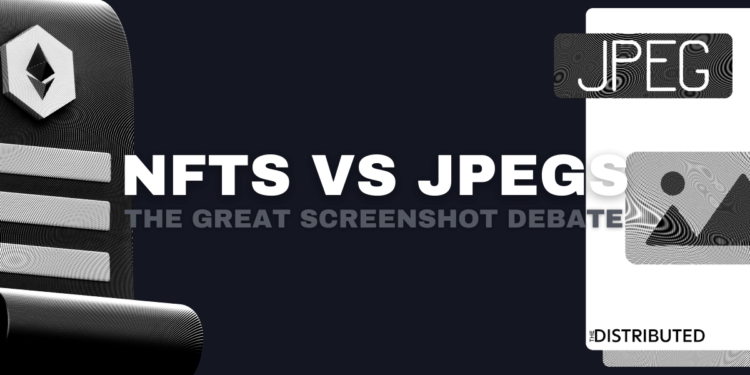What Is An NFT?
Non-Fungible Tokens (NFTs) are digital assets based on a blockchain and are linked with distinctive codes and metadata to separate them from other tokens on the blockchain. In a direct comparison, NFTs cannot be traded like cryptocurrencies despite being based on a blockchain. NFTs cannot be guaranteed to trade for the amount they’re bought for.
What Is A JPEG?
Joint Photographic Experts Group (JPEGs) are a standard image format for containing lossy and compressed image data. The ability for photos to be compressed make it a standard across much of the internet, being quick and easy to send back and forth between various devices.
NFTs vs JPEGs: The Screenshot Debate
Naturally, when something is screenshotted on the internet it takes the form of a JPEG. Although you can screenshot an NFT, this doesn’t make you the owner of it, nor does a screenshot have any value. NFTs are more than the image, it is ownership of the image.
This is because NFTs are generally Ethereum ERC-721 tokens or the equivalent for a separate blockchain. ERC-721 tokens are digital assets based on a blockchain and are linked with distinctive codes and metadata to separate them from other tokens on the blockchain.
ERC-721 implements an API for smart contracts allowing for defining features in an asset to be preserved. This feature would allow for the transfer of NFTs while being able to trace them back to their original smart contract address to ensure their legitimacy.
These types of tokens can be used to create unique artworks, memorabilia, trading cards, and tickets for certain events. So if you were to screenshot an NFT of a ticket to a sporting event and cannot prove that you have an original copy by tracing it back through the blockchain, you will not gain access to the event.
Are NFTs Just Pictures?
Every NFT is different, and these differences are what value one art piece more than another. The digital scarcity of an NFT is what drives a majority of its value. In the NFTs vs JPEGs debate, NFTs can retain value over time due to certain assets linked to the NFT, JPEGs will always be just the picture.
You may see some NFTs from the same collection sell for millions and some for thousands, this is due to the rarity of assets linked to the NFT. Certain NFTs have rare attributes, the rarer the attribute the rarer the NFT, much like trading cards where the better characters are harder to find and more sought after.
While NFTs themselves hold a lot of value, NFTs can offer more than just the art piece you buy. One of the most popular NFT collections, Bored Ape Yacht Club, gives access to their Miami Clubhouse, only to owners of their NFT. NFTs are sometimes more than just art, they can be one way to expand your network. With celebrities being a part of these networks a couple hundred thousand for access to these people may seem worth the price to certain investors.
Can JPEGs Be NFTs?
Despite a screenshot of NFT being worthless, JPEGs can actually be minted as NFTs.
Most artwork NFTs start off as JPEGs anyways and those have no actual value. So once you convert a JPEG to an NFT by linking it to an ERC-721 NFT Contract it will then ‘gain value’.
But if you were to screenshot an NFT and then upload it back onto the blockchain under your own ERC-721 NFT Contract, users will be able to compare the contract linked back to the NFT and see that it isn’t the official contract. You can find the verified contracts of certain NFT projects using a site like Etherscan.
What Does Minting Your NFT Mean?
Minting is the process of adding your NFT to a blockchain, a public ledger that is tamper-proof and is where you can verify the owners of various NFTs.
When you buy an NFT from somewhere like Opensea, the artist mints the NFT before listing it for sale. This allows you to verify the legitimacy of it on the same page you will buy from.



